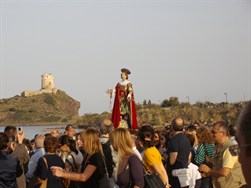The Feast of Sant’Efisio in Cagliari
 The current Feast of Sant’Efisio (Saint Ephysius) was born in the mid-seventeenth century on the occasion of a terrible plague. The city authorities of Cagliari instituted it to commemorate the cessation of the disease thanks to the miraculous intervention of the Protector (revered for centuries in the capital of Sardinia). Since then, the ceremony includes a procession which goes from Cagliari to the seaside town of Nora (near the town of Pula). Nora is the site of the martyrdom of a Roman soldier named EphysiusEphisius was a military man who lived between the third and fourth centuries A.D. at the time of the Emperor Diocletian. He arrived in Sardinia from Antioch with a mandate to protect the interests of the empire, was converted to Christianity and was beheaded in Nora on 15 January of the year 303., which occurred in the fourth century A.D. as a result of his conversion to Christianity. The festivitiesThe procession of the saint leaves from the church of the quarter of Stampace on 1 May which houses the sacred effigy. The next day it goes to Nora and from there on 4 May it goes to Cagliari. An impressive number of people participate in the endless parade, which goes on for over thirty kilometres, dressed in traditional costume, on horseback, coming from every part of the island. The Mayor carries the Golden Fleece, the prestigious chain granted by the Spanish king to the Grandees of the Kingdom. are held each year from the first to the fourth of May and start with the parade of the traccas: traditional festively decorated wagons pulled by oxen. The statue of the saint is carried in procession on a golden chariot (eighteenth century), also drawn by oxen adorned with flowers, preceded by people who play launeddas (an ancient Sardinian woodwind instrument). The wagon of Sant’Efisio is followed by giant candles in memory of an ancient tradition, the oblation of wax, still in use today in Sassari during the Feast of the Assumption. The parade is accompanied by costumed figures, embodying the ancient royal militias hired to defend the pageant from the plundering of the Moors.
The current Feast of Sant’Efisio (Saint Ephysius) was born in the mid-seventeenth century on the occasion of a terrible plague. The city authorities of Cagliari instituted it to commemorate the cessation of the disease thanks to the miraculous intervention of the Protector (revered for centuries in the capital of Sardinia). Since then, the ceremony includes a procession which goes from Cagliari to the seaside town of Nora (near the town of Pula). Nora is the site of the martyrdom of a Roman soldier named EphysiusEphisius was a military man who lived between the third and fourth centuries A.D. at the time of the Emperor Diocletian. He arrived in Sardinia from Antioch with a mandate to protect the interests of the empire, was converted to Christianity and was beheaded in Nora on 15 January of the year 303., which occurred in the fourth century A.D. as a result of his conversion to Christianity. The festivitiesThe procession of the saint leaves from the church of the quarter of Stampace on 1 May which houses the sacred effigy. The next day it goes to Nora and from there on 4 May it goes to Cagliari. An impressive number of people participate in the endless parade, which goes on for over thirty kilometres, dressed in traditional costume, on horseback, coming from every part of the island. The Mayor carries the Golden Fleece, the prestigious chain granted by the Spanish king to the Grandees of the Kingdom. are held each year from the first to the fourth of May and start with the parade of the traccas: traditional festively decorated wagons pulled by oxen. The statue of the saint is carried in procession on a golden chariot (eighteenth century), also drawn by oxen adorned with flowers, preceded by people who play launeddas (an ancient Sardinian woodwind instrument). The wagon of Sant’Efisio is followed by giant candles in memory of an ancient tradition, the oblation of wax, still in use today in Sassari during the Feast of the Assumption. The parade is accompanied by costumed figures, embodying the ancient royal militias hired to defend the pageant from the plundering of the Moors.
